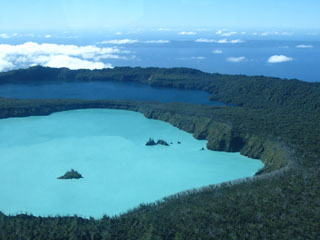Report on Ambae (Vanuatu) — 25 July-31 July 2018
Smithsonian Institution / US Geological Survey
Weekly Volcanic Activity Report, 25 July-31 July 2018
Managing Editor: Sally Sennert.
Please cite this report as:
Global Volcanism Program, 2018. Report on Ambae (Vanuatu) (Sennert, S, ed.). Weekly Volcanic Activity Report, 25 July-31 July 2018. Smithsonian Institution and US Geological Survey.
Ambae
Vanuatu
15.389°S, 167.835°E; summit elev. 1496 m
All times are local (unless otherwise noted)
Vanuatu Meteorology and Geo-hazards Department (VMGD) reported that during overflights on 13 and 20 July, observers took photos of explosions at Ambae’s Lake Voui ejecting hot tephra from vents and producing ash plumes. Increased activity prompted VMGD to raise the Alert Level to 3 (on a scale of 0-5) on 21 July, and warn residents to stay at least 3 km away from the active crater. The report noted that current activity was similar to that in March, but with more sustained ash emissions. [Ash plumes continued over the next few days, and resulted in darkness during daytime on the 24th.] At about 2100 on 26 July explosions generated an ash cloud that rose as high as 12 km above the vent and spread NE, E, and SE. According to news articles, the event... prompted an order for an island-wide evacuation of the 10,000 residents. Another explosive event occurred early on 27 July. The Wellington VAAC reported sulfur dioxide emissions, and ash plumes rising to 2.4-4.6 km (8,000-15,000 ft) a.s.l. and drifting SE and NW. Pilots reported heavy ashfall over eastern Fiji. Smaller events producing ash-and-gas emissions continued throughout the day. On 1 August VMGD stated that the ashfall has had a significant impact on the island’s food and water supplies, and the health of the island residents.
Geological Summary. The island of Ambae, also known as Aoba, is a massive 2,500 km3 basaltic shield that is the most voluminous volcano of the New Hebrides archipelago. A pronounced NE-SW-trending rift zone with numerous scoria cones gives the 16 x 38 km island an elongated form. A broad pyroclastic cone containing three crater lakes (Manaro Ngoru, Voui, and Manaro Lakua) is located at the summit within the youngest of at least two nested calderas, the largest of which is 6 km in diameter. That large central edifice is also called Manaro Voui or Lombenben volcano. Post-caldera explosive eruptions formed the summit craters about 360 years ago. A tuff cone was constructed within Lake Voui (or Vui) about 60 years later. The latest known flank eruption, about 300 years ago, destroyed the population of the Nduindui area near the western coast.
Sources: Vanuatu Meteorology and Geohazards Department (VMGD), Wellington Volcanic Ash Advisory Center (VAAC), Radio New Zealand, Radio New Zealand

